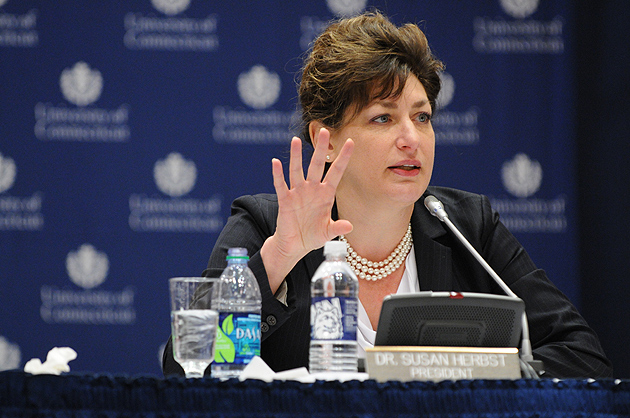
The Board of Trustees today passed a four-year tuition and fee plan that will allow the University to significantly expand its teaching and research capabilities by adding 290 professors to its faculty by fiscal year 2016.
Under the plan, the total cost of attending UConn – tuition, fees, room and board – will rise by about 4.5 percent over each of the next four years. If UConn’s state appropriation increases by 0.5 percent during each of the next four years, tuition and fees would rise by between 5.5 percent and 6.3 percent each year. If UConn’s state appropriation remains the same over the next four years, tuition and fees will rise by between 6.0 percent and 6.8 percent each year. Room and board costs will increase by 3 percent.
The revenue these increases will generate will go to hiring additional faculty in order to decrease UConn’s student-to-faculty ratio, expand course offerings, and help students to graduate on time. Every semester a student attends the University beyond four years as an undergraduate means additional tuition, fee, room and board costs – which are far greater than the cost of the tuition increase.

“Professors in the classroom and the students they teach are the heart and soul of a university,” said UConn President Susan Herbst. “The 290 new professors this will allow us to hire will go a long way in helping students get the courses they need when they need them so they can graduate on time. It will have a dramatic and incredibly positive effect on our students and our overall research capacity for years to come. The people of Connecticut have built a great university and this will allow us to best serve the state, advance as an institution, and become even better.”
The extraordinary growth in UConn’s student enrollment has far outpaced the growth in faculty; from 1995 to 2011, undergraduate enrollment increased by 53 percent – from 14,667 to 22,472 – while the number of faculty at UConn has increased by only 16 percent over the same period – from 1,148 to 1,330. UConn’s student-to-faculty ratio was 14-to-1 in 1996; it is now 18-to-1. The University’s goal is for the ratio to be 15-to-1, which this plan will accomplish.
Every increase in tuition is matched by an increase in financial aid, to help mitigate the effect of the increase. About three-quarters of UConn students received financial aid in 2011, including loans, grants, and scholarships, both need-based and merit-based. Next year, 20 cents of every net tuition dollar will go to need-based financial aid for UConn students. The rate at which UConn graduates default on their debt is 2.4 percent, compared to the national rate of 7 percent.
Among the top 25 public universities in the nation – UConn ranked 19th in the most recent U.S. News listing – UConn had the third lowest tuition increase last year at 2.4 percent. UConn’s 2012 tuition and mandatory fee cost places it at 26th in terms of cost, or in the middle of the top 53 public universities in the U.S.





